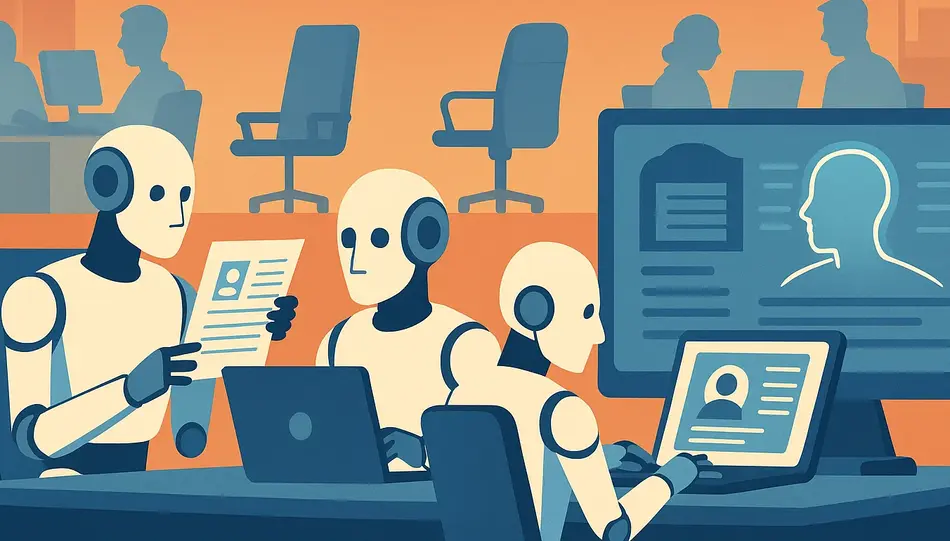The Age of AI is redefining how recruitment works. From automated resume screening to algorithmic candidate outreach, both job seekers and employers are adapting to a world where human judgment is being replaced by machine intelligence. What was once a people-driven process is now powered by data, raising important questions about bias, experience, and the future of work.
1. Age of AI and his Algorithmic of Hiring
Over the past three years, the number of large employers relying on AI‑powered applicant‑tracking systems (ATS) has more than doubled. These platforms scan resumes for keywords, enforce formatting rules, and even assign “fit scores” based on parsed data. Video‑interview tools use facial‑recognition and natural‑language‑processing models to evaluate tone, micro‑expressions, and response patterns—often before a single human recruiter sees the candidate.
For employers, these systems promise efficiency: sorting hundreds of applications in seconds, flagging likely top performers, and reducing time‑to‑hire by up to 40 percent. But for applicants, the experience can feel dehumanizing, opaque, and prone to error.
2. Candidate Frustrations Amplified
2.1 The Black Box Resume Filter
Applicants report that slight deviations in resume formatting—tables, nonstandard fonts or even headers called “Experience” instead of “Work History”—can result in automatic rejection. With many ATS configured to prioritize exact keyword matches, qualified candidates often never reach a recruiter’s desk.
2.2 Bot‑Driven Interviews
Tools that analyze recorded video answers have become commonplace. Candidates are judged on speech cadence, facial muscle movements, and specific vocabulary use. Many find this process stressful and unnatural, likening it to “performing for a robot” rather than engaging with a human.
2.3 Ghosting at Scale
Automated mass‑communications platforms now send thousands of rejection emails or text messages at the click of a button. Personalization is minimal, and follow‑up is rare, which leaves many applicants feeling discarded and disconnected.
3. Employers’ Balancing Act
3.1 Efficiency vs. Equity
While AI screening can cut workload for busy teams, it also risks perpetuating biases encoded in training data. If an algorithm is fed historical hiring outcomes that underrepresent certain groups, it may learn to favor candidates with similar profiles—regardless of individual merit.
3.2 The Candidate‑Experience Tradeoff
Companies fiercely compete for top talent. Yet when early engagement feels mechanical, organizations risk alienating candidates before they even accept an offer. Some forward‑looking firms are injecting human touchpoints—brief phone calls after initial AI screening, small‑group video Q&As with hiring managers, or AI‑driven chatbots that offer richer, two‑way conversation.
3.3 Legal and Compliance Risks
Regulators in several states are scrutinizing AI‑based hiring tools under anti‑discrimination laws. Employers must now validate that their systems do not disproportionately screen out protected classes—an often complex and costly undertaking.
4. New Roles, New Skills
As machines take over routine tasks, demand has surged for roles that blend technical and interpersonal skills:
- AI Talent Specialists: Professionals who curate and train hiring algorithms, ensure data quality, and audit for bias.
- Candidate Experience Designers: HR specialists focused on mapping and optimizing every interaction point—email, chatbot, interview—for clarity and empathy.
- Human‑in‑the‑Loop Coordinators: Recruiters who intervene judiciously at key decision points to supplement algorithmic screening with human insight.
For job seekers, new advice centers on understanding how to “optimize for the bot”: incorporating relevant keywords, practicing answers to common AI‑screened questions, and honing digital presentation skills.
Hiring in the Age of AI? Post Jobs for Emerging Roles
The Age of AI is creating demand for a new class of professionals—AI Talent Specialists, Candidate Experience Designers, and Human‑in‑the‑Loop Coordinators. These roles blend data fluency, empathy, and ethical oversight. If your company is hiring for the future, post your openings on WhatJobs and connect with forward-thinking candidates today.
Post Your Job Listing Now →5. Case Studies: Experimentation and Backlash
5.1 A Global Bank’s Short‑Circuit
One multinational bank deployed an AI resume filter that cut preliminary screening time in half. After six months, however, leadership discovered the system routinely screened out candidates from regional campuses with nonstandard transcripts. A rapid rollback ensued, and a hybrid process combining algorithmic sorting with human review was reinstated.
5.2 A Tech Startup’s Chatbot Revolution
A rapidly growing software firm introduced a conversational AI assistant to handle candidate FAQs, schedule interviews, and provide real‑time feedback on application status. Candidate satisfaction scores climbed 20 percent, and recruiters regained hundreds of hours previously spent on administrative outreach.
5.3 The Union’s Challenge
A large public‑sector union sued its city employer, alleging that AI‑driven screening for civil service roles violated the municipal charter’s merit‑based hiring requirements. The case is now before a state administrative board, and many employers are watching the outcome closely.
6. Strategies for Job Seekers
- Audit Your Keywords: Match your resume language to the job description without overstuffing.
- Master Video Presence: Practice on platforms that simulate AI scoring; focus on clear speech and authentic delivery.
- Leverage Referrals: Strong internal references can help bypass early algorithmic filters.
- Cultivate a Personal Brand: A LinkedIn profile optimized for search and rich with endorsements can boost automated rankings.
- Stay Informed: Research your target companies’ use of AI hiring tools and tailor your approach accordingly.
7. Recommendations for Employers
- Validate and Monitor: Regularly test AI tools with diverse applicant pools to detect unintended bias.
- Blend Human and Machine: Reserve early‑stage automation for administrative tasks; keep critical assessments within human purview.
- Enhance Transparency: Inform candidates when AI is used, explain key criteria, and offer clear appeal or human review processes.
- Invest in Training: Equip HR teams with data‑science literacy to interpret algorithmic outputs responsibly.
Frequently Asked Questions (FAQ)
Is AI screening mandatory?
No—many small and mid‑sized employers still use manual or hybrid processes. AI adoption varies widely by industry and company size.
Can AI replace recruiters?
Not entirely. While AI excels at data sorting, human recruiters remain essential for relationship‑building, nuanced judgment, and final decision‑making.
Are AI hiring tools legal?
Yes, if properly validated and audited to ensure they do not discriminate against protected groups. Compliance with anti‑bias standards is critical.
How can I tell if an employer uses AI?
Look for automated scheduling links, rapid “instant” rejection emails, or chatbot interactions early in the application process. Employers may also disclose their use of AI tools in job postings.
Conclusion
In the age of AI, the future of job hunting and hiring hinges on striking a balance: harnessing machine efficiency while preserving human empathy and judgment. Organizations and candidates who adapt thoughtfully to this evolving dynamic stand to win in a marketplace where technology—and humanity—must go hand in hand.




